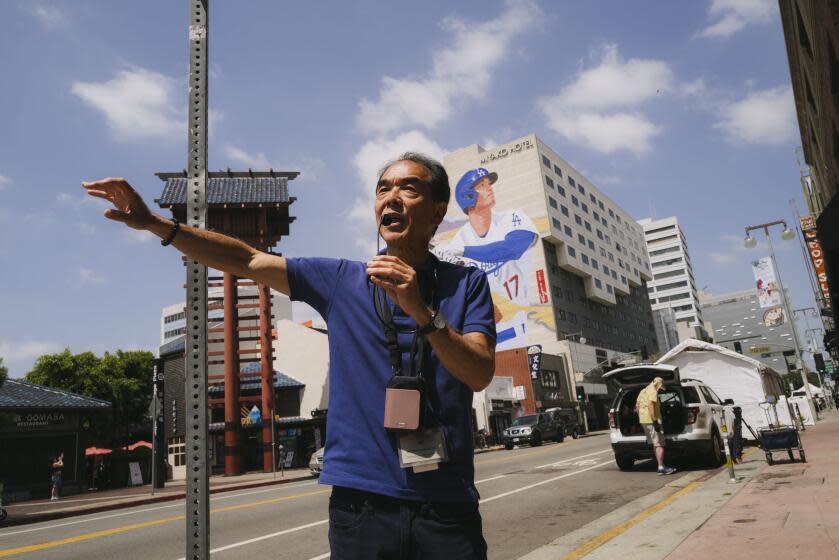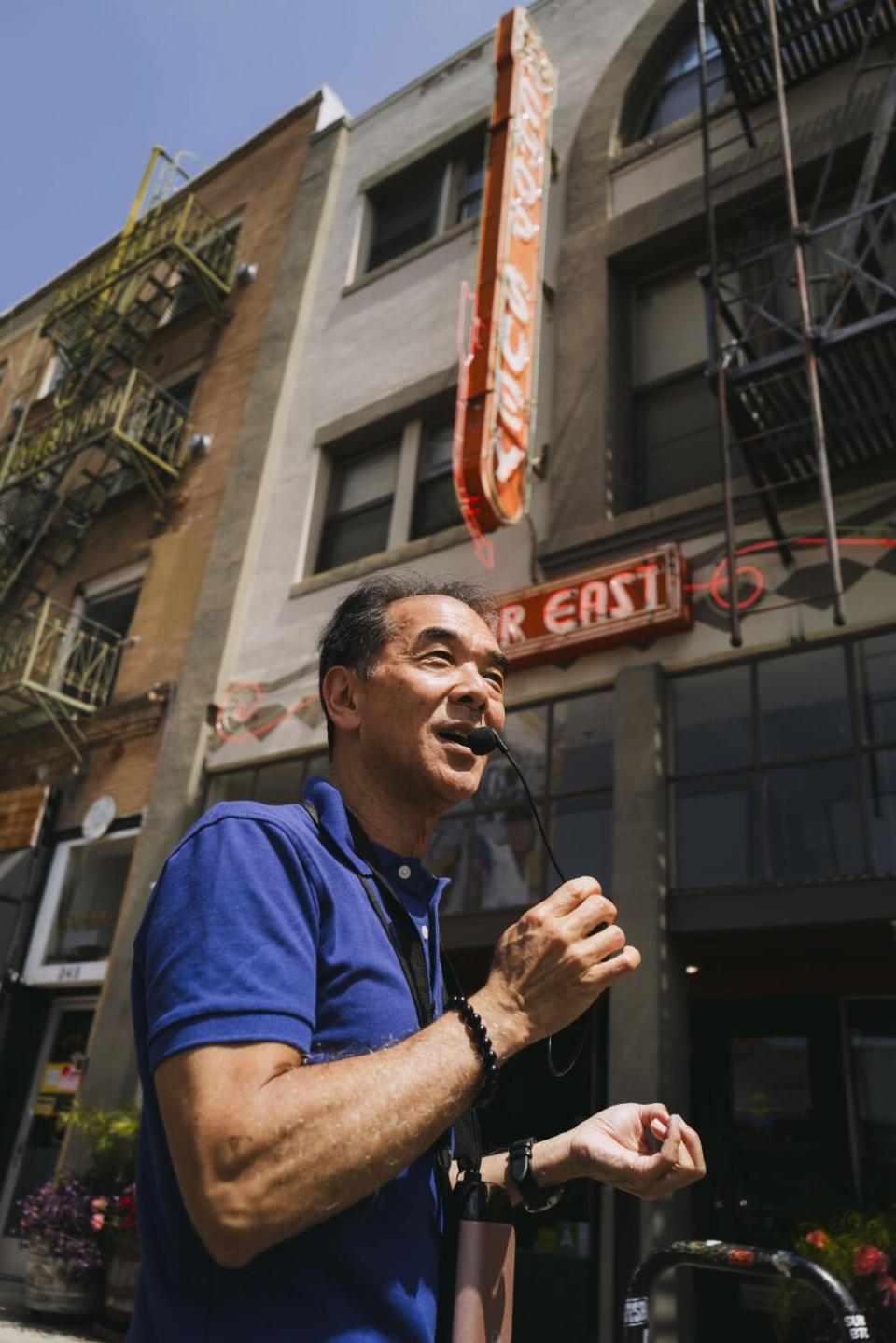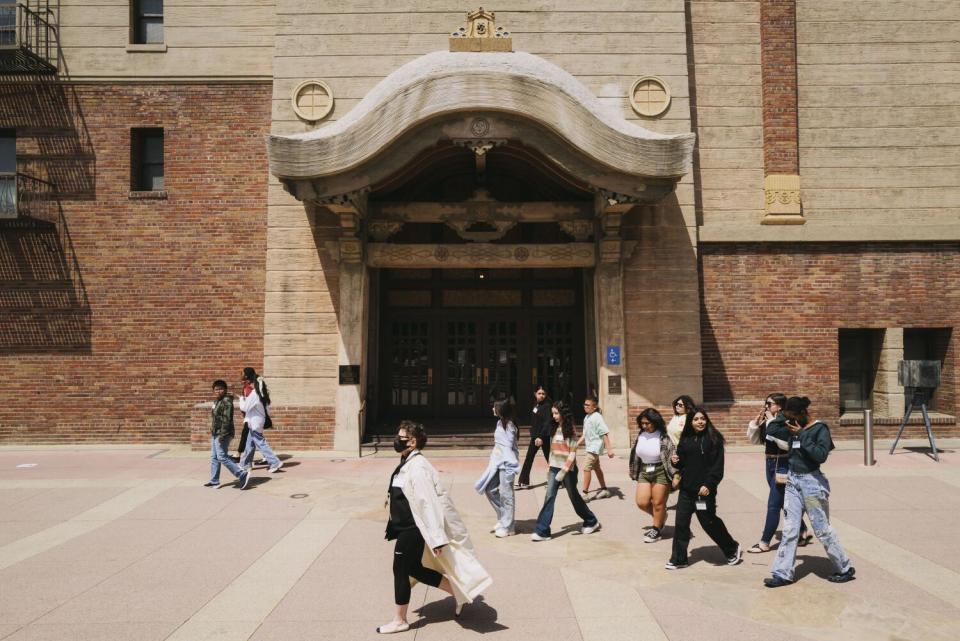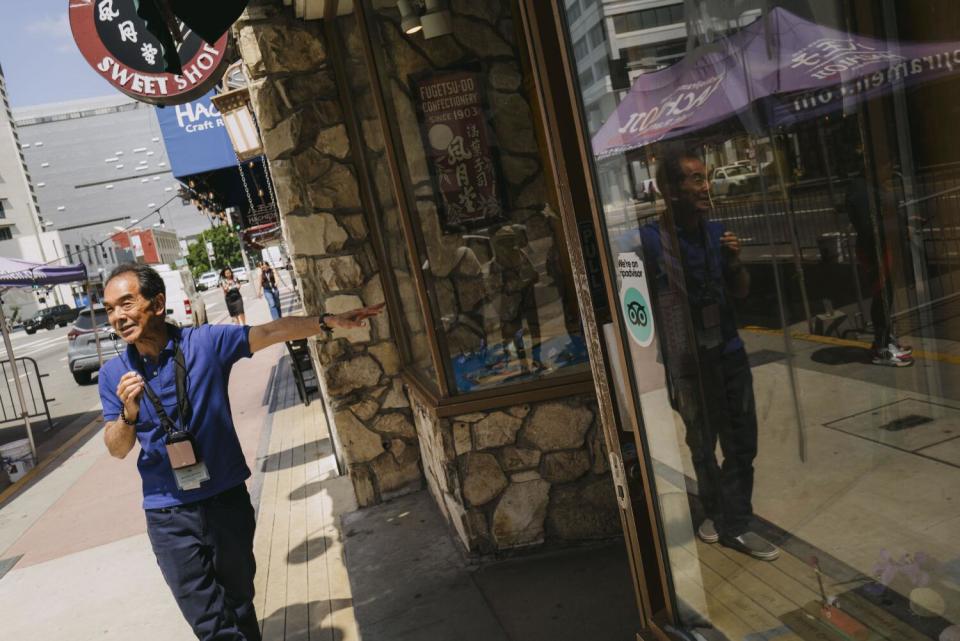Little Tokyo named one of America's most endangered places by preservation group

- Oops!Something went wrong.Please try again later.
Change has always come hard and fast to Little Tokyo. As one of the oldest neighborhoods in Los Angeles, it has shape-shifted over the last 140 years under the forces of urban renewal and gentrification, as well as the unjust wartime incarceration of its residents.
Recent years have seen continued evictions, closures and relocations among businesses that were once staples of the community. The forced relocation of Suehiro Cafe sparked a recent street protest calling attention to the demise of establishments that once were the anchors of this historic community.
Citing a need to save the identity of one of Los Angeles' most culturally distinct neighborhoods, the National Trust for Historic Preservation announced Wednesday that Little Tokyo has been designated as one of America’s 11 most endangered historic places.
“We hope that by bringing attention to displacement and gentrification occurring in the neighborhood, Los Angeles’ Little Tokyo can get the support and policy protections needed, so that the community can thrive long into the future,” said Carol Quillen, president and chief executive of the trust.

Little Tokyo joins, among other sites, the Texas home of country singer Cindy Walker, a lighthouse on the Hudson River in New York, a sugar plantation on the U.S. Virgin Islands and one of the country’s first all-Black municipalities, Eatonville, Fla.
The designation of Little Tokyo, which comes as the downtown L.A. neighborhood is about to celebrate its 140th anniversary, is the result of efforts by Sustainable Little Tokyo, a broad coalition of local interests that includes the Japanese American National Museum and the Little Tokyo Community Council.
Kristin Fukushima, managing director of the Little Tokyo Community Council, considers the trust’s decision “another step in a long journey looking at preservation as a tool for survival, securing our future and fighting off displacement.”
“It doesn’t come with guarantees or funding,” she said, “but it does provide us with a national platform to spotlight our neighborhood.”
Since 1988, the National Trust for Historic Preservation has published an annual list of sites — homes, neighborhoods, even highways — that are vulnerable to redevelopment and that “illustrate the complexities and challenges that have always been part of what it means to be American.” Many of these locales — often landmarks in ethnic communities — have been overlooked or ignored.
Last year’s list included Philadelphia’s Chinatown, which Fukushima said helped inspire Little Tokyo’s application.
In awarding this status, the trust looks for places of historical significance “that tell the whole American story,” Quillen said, and among other criteria, offer a solution — “a path toward enlivening the site so it becomes the center of activity that those preserving it want it to be.”

This year, said Quillen, the trust received 111 letters of intent from 40 states and territories; 28 were advanced to the next round and of those, 11 were selected.
In describing Little Tokyo's application, Quillen specifically pointed to the vision that the Sustainable Little Tokyo coalition has for its future.
“Their initiatives are policy-directed,” she said, and include expanding the city’s legacy business program; giving the community a voice in new development projects; and preserving cultural heritage, while serving the present community.
“This is not a place to be frozen in amber but is instead looking to create a Little Tokyo that is vibrant and alive and serving communities in the present through this rich cultural heritage,” she said.
The Sustainable Little Tokyo coalition hopes the endangered status will draw attention to the fragile character of the neighborhood, which is home to 400 small businesses that are facing pressures related to development in the area. Fifty of them are considered "legacy businesses" — defined as at least 20 years old.
From 2008 to 2023, at least 50 businesses 10 years or older have closed or relocated due to rising rent, according to the Little Tokyo Service Center, which has been fighting for more control over development that would provide more affordable housing, cultural centers and green spaces.
"We would have had more legacy businesses if we hadn’t lost so many over the years," said Fukushima.

Suehiro Cafe's 1st Street location is one of the most recent casualties — the restaurant is now operating at 4th and Main streets — but it is not alone. Little Tokyo Arts & Gifts has closed, as has the Family Mart convenience store. Anzen Hardware is moving to a building down the street. Little Tokyo Cosmetics was forced to leave on the eve of its fifth anniversary. The Shabu Shabu House — the first restaurant of its kind in the U.S. — closed after 32 years.
The neighborhood was especially impacted by Metro’s Regional Connector project, with its construction delays, and by the effect that transit projects often have on the cost of rental properties.
“Little Tokyo is facing a number of existential threats that are causing changes to the neighborhood, including driving up rents and driving out small businesses,” said Kristen Hayashi, a curator for the Japanese American National Museum.
Hayashi cites among these threats not only the pressures of gentrification and the Regional Connector project, but also the city’s plan to replace the former LAPD headquarters, Parker Center.
“Saving Little Tokyo is definitely daunting,” Fukushima said, adding a $2-billion mega-project coming to the Arts District to her list of concerns.
“We talk to some community members who have been doing this work for 50 years, and there is fatigue," she said. "They ask, 'What can we do about it? The gears are in motion. How can we stop these broader impacts that other communities have not been able to do anything about?' But Little Tokyo’s history is rooted in a stubbornness that doesn’t allow us to give up.”
Hayashi said that Little Tokyo’s importance to Los Angeles extends beyond its boundaries.
“Why should we care about Little Tokyo?" she asked. "In addition to being at the heart of the Japanese American community in Los Angeles, it reflects the diversity that has always characterized this city. It represents a time in the city’s history when housing covenants dictated where Japanese Americans could live, and this became their refuge from discrimination, a place that provided them a taste of home.”
Although over the years its footprint has grown smaller, Hayashi is confident the community will endure.
“This community cares too much,” she said. “We’re trying to future-proof Little Tokyo, to preserve its history and make sure people don’t forget the roots of the place.”
This story originally appeared in Los Angeles Times.

